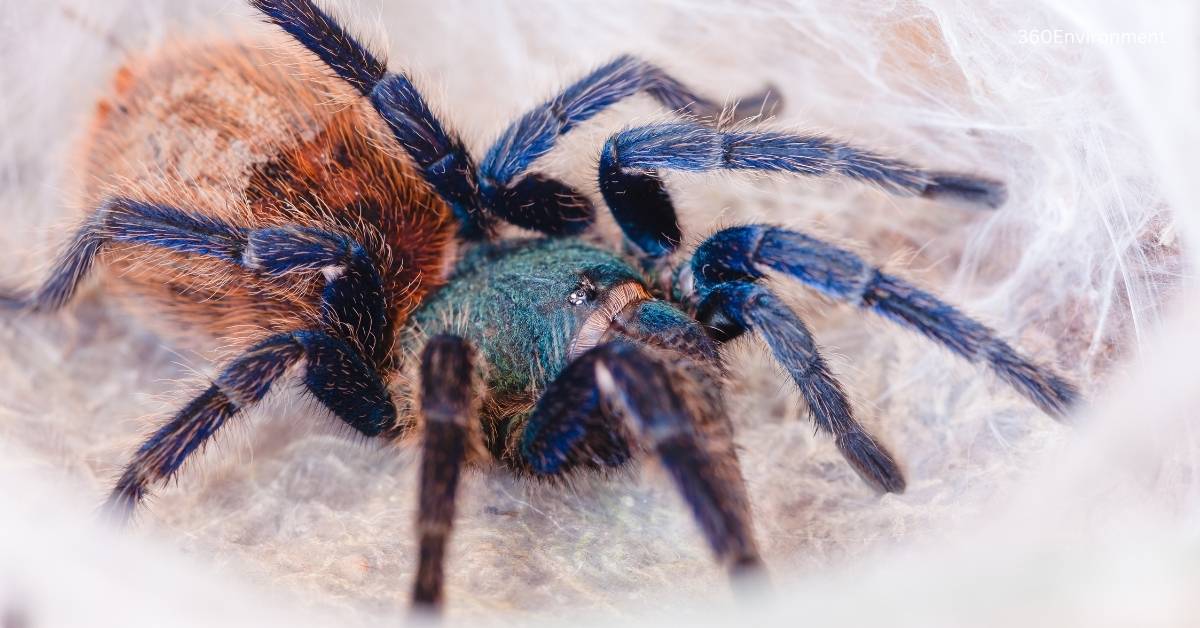Chromatopelma Cyaneopubescens, commonly known as the Greenbottle Blue Tarantula, is one of the most visually striking and captivating species in the world of arachnids. Native to the arid regions of northern Venezuela, particularly around the Paraguaná Peninsula, this tarantula has gained popularity in both the exotic pet trade and among entomologists due to its vibrant coloration and fascinating behaviors. However, beyond its beauty lies a creature finely adapted to its specific environment.
The environmental niche of Chromatopelma Cyaneopubescens encompasses its habitat preferences, ecological role, interactions with other organisms, and adaptations to survive in its unique desert-like environment. In this article, we explore these facets in detail, aiming to provide a comprehensive understanding of this tarantula’s place within its ecosystem.
1. Taxonomy and Morphology of Chromatopelma Cyaneopubescens
Before delving into the environmental niche of this species, it is essential to understand its taxonomy and physical characteristics. Chromatopelma cyaneopubescens belongs to the family Theraphosidae, which is home to many large and often colorful tarantulas.
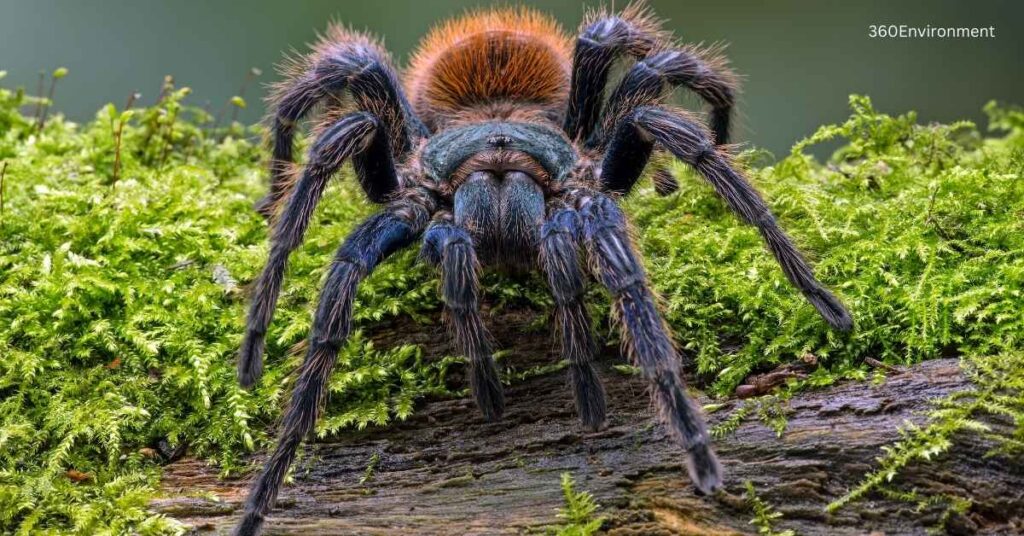
1.1. Taxonomy
- Kingdom: Animalia
- Phylum: Arthropoda
- Class: Arachnida
- Order: Araneae
- Family: Theraphosidae
- Genus: Chromatopelma
- Species: C. cyaneopubescens
The genus Chromatopelma is monotypic, meaning it contains only this single species. The name cyaneopubescens refers to the bluish, hair-covered body of the tarantula, while Chromatopelma references its remarkable chromatic appearance.
1.2. Morphology
Chromatopelma cyaneopubescens is known for its brilliant blue legs, metallic green carapace, and bright orange or reddish abdomen covered with long, vibrant setae (hair-like structures). This dazzling coloration, unusual among tarantulas, makes it an attractive species both for scientific study and for tarantula enthusiasts.
The spider’s body length typically ranges between 12 to 15 centimeters (about 4.5 to 6 inches) when fully grown, with a leg span extending up to 17 centimeters. Like other tarantulas, C. cyaneopubescens possesses a set of fangs that deliver venom to subdue prey, though its venom is relatively mild and primarily used for hunting rather than defense.
2. Habitat and Geographic Distribution
Understanding the environmental niche of Chromatopelma cyaneopubescens begins with examining the habitat in which it evolved. This tarantula is native to the dry, scrubland regions of northern Venezuela, particularly the Paraguaná Peninsula. The environment in this area is characterized by arid, desert-like conditions, sparse vegetation, and extreme temperature fluctuations.
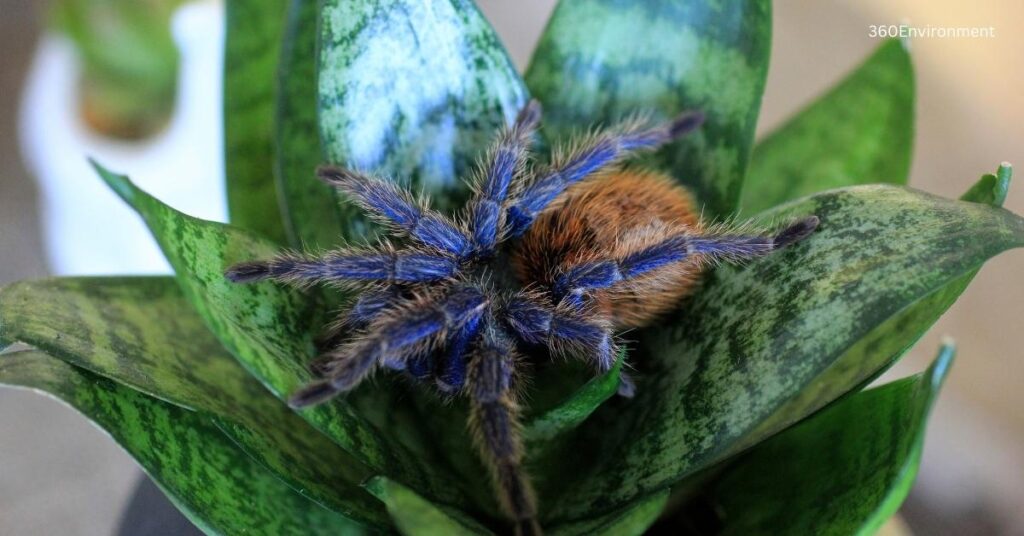
2.1. Habitat Preferences
The arid regions of northern Venezuela offer a harsh but suitable environment for chromatopelma cyaneopubescens. This species thrives in habitats that feature dry, sandy soils with sparse shrubs and grasses. Unlike many tarantulas that prefer moist, forested areas, chromatopelma cyaneopubescens has adapted to live in areas with minimal rainfall and high temperatures.
- Soil and Substrate: The sandy, well-drained soils of the region are ideal for burrowing, which is a primary behavior of chromatopelma cyaneopubescens. These spiders create burrows or take refuge under rocks and vegetation to escape the harsh daytime heat and potential predators.
- Vegetation: The scrubland vegetation provides cover and prey opportunities for the tarantula. Shrubs and small plants attract insects, which serve as the primary food source for the spider. The sparse nature of the vegetation also allows for better visibility and easier hunting for this species.
2.2. Climate and Environmental Conditions
The Paraguaná Peninsula is an arid environment with very little annual rainfall, typically receiving less than 500 millimeters (20 inches) per year. The climate is hot and dry, with daytime temperatures often exceeding 30°C (86°F) and dropping significantly at night. The desert-like conditions, characterized by high heat and low humidity, create a unique set of challenges for survival, but C. cyaneopubescens has evolved specific adaptations to thrive in such an environment.
- Temperature Regulation: Like all arachnids, tarantulas are ectothermic, meaning they rely on external temperatures to regulate their body heat. C. cyaneopubescens spends much of the day in its burrow or hidden under rocks to avoid the intense heat. During cooler periods, such as early morning or evening, it emerges to hunt and carry out other activities.
- Water Conservation: In an environment where water is scarce, this tarantula has evolved mechanisms to minimize water loss. The exoskeleton of C. cyaneopubescens helps prevent desiccation, and it obtains much of the moisture it needs from its prey rather than relying on direct water sources.
2.3. Geographic Distribution
The natural distribution of Chromatopelma cyaneopubescens is limited to northern Venezuela, particularly the arid regions of the Paraguaná Peninsula. However, due to its popularity in the pet trade, individuals of this species are now found in captivity worldwide, with breeders and hobbyists working to maintain healthy captive populations.
3. Ecological Role and Trophic Interactions
As a predator, Chromatopelma cyaneopubescens plays a key role in controlling insect populations within its habitat. Its ecological role, however, extends beyond simply being a predator. The spider also influences the microhabitats in which it lives and interacts with other organisms in its environment.
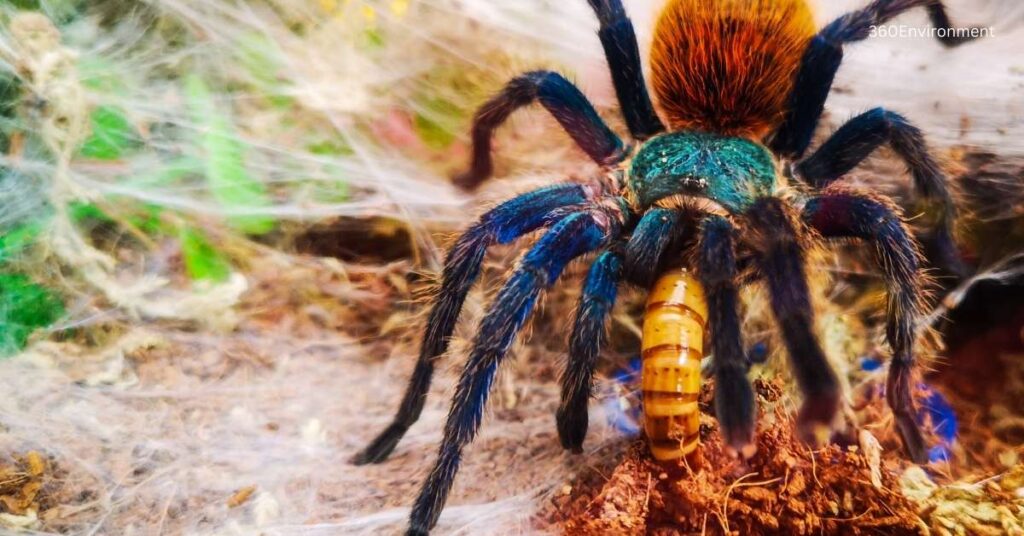
3.1. Role as a Predator
Like other tarantulas, Chromatopelma cyaneopubescens is an opportunistic predator that feeds primarily on insects and other small invertebrates. Its diet includes crickets, beetles, moths, and other arthropods that are common in its habitat.
- Hunting Strategy: This tarantula is primarily a sit-and-wait predator. It relies on its burrow as a home base from which it can ambush prey. Using its sensitive hairs (setae), it detects vibrations caused by the movement of nearby prey. Once the prey is within reach, the tarantula lunges forward, injecting venom to immobilize and digest it externally before consuming the liquefied remains.
- Impact on Prey Populations: By preying on insects, Chromatopelma cyaneopubescens helps regulate populations of these species, preventing outbreaks that could damage vegetation or otherwise alter the balance of the ecosystem. This predatory pressure maintains a healthy balance in the food web of its environment.
3.2. Interaction with Other Species
In addition to its role as a predator, Chromatopelma cyaneopubescens interacts with a variety of other species, including competitors, prey, and potential predators.
- Competition: Although tarantulas generally avoid direct competition, Chromatopelma cyaneopubescens may compete with other arachnids, reptiles, or small mammals for food resources. The ability to construct burrows and web shelters allows the tarantula to reduce direct competition by exploiting microhabitats that other predators may overlook.
- Predators: Chromatopelma cyaneopubescens has few natural predators due to its relatively large size and venomous bite. However, it is still vulnerable to birds, larger mammals, and some reptiles that can prey on it, especially when it is outside its burrow. Its main defense mechanisms include retreating into its burrow, using its speed to escape, and deploying urticating hairs that can irritate and deter predators.
3.3. Role in Soil and Microhabitat Modification
The burrowing behavior of Chromatopelma cyaneopubescens plays a crucial role in modifying its environment. These burrows not only provide shelter for the tarantula but also create microhabitats for other organisms, such as smaller insects and invertebrates, which may use abandoned burrows or take refuge in the shelter provided by the spider’s webbing.
- Soil Aeration: By digging and maintaining burrows, the tarantula contributes to soil aeration and water infiltration, improving the quality of the soil and helping to maintain plant health in the surrounding area.
- Webbing: While most tarantulas do not construct elaborate webs for capturing prey, Chromatopelma cyaneopubescens is known to create silk retreats that line its burrow entrance. This webbing helps the tarantula detect prey and provides structural stability to its burrow, particularly in sandy soils.
4. Adaptations to the Arid Environment
Surviving in the harsh, arid conditions of the Paraguaná Peninsula requires a variety of physiological, behavioral, and structural adaptations. Chromatopelma cyaneopubescens has evolved a range of strategies to cope with the extreme temperatures, lack of water, and limited resources in its environment.
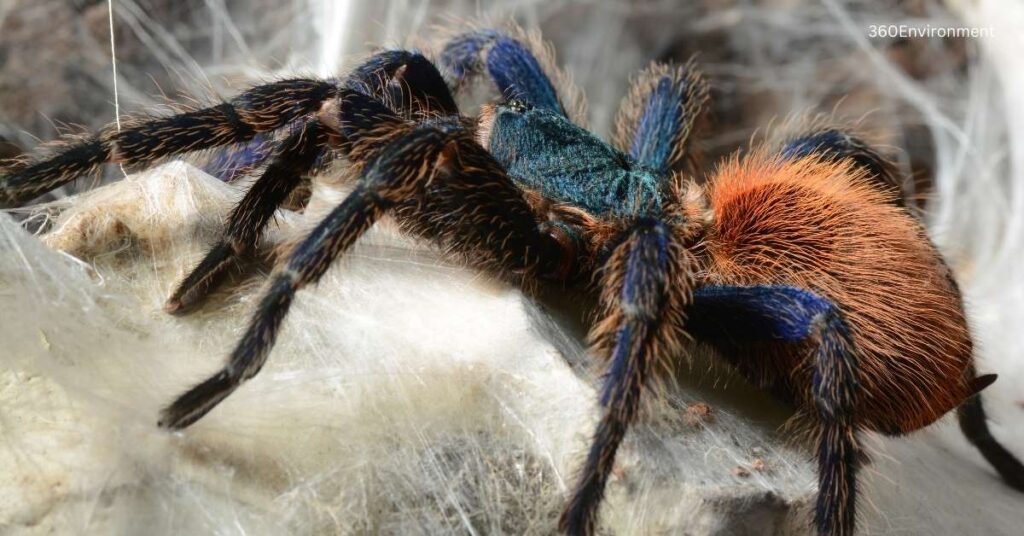
4.1. Water Conservation
Water is a precious resource in the desert, and Chromatopelma cyaneopubescens has developed efficient ways to minimize water loss.
- Exoskeleton: The thick, waxy exoskeleton of the tarantula helps reduce water loss through evaporation. This is particularly important in the dry, windy conditions of its habitat.
- Behavioral Adaptations: The tarantula spends the hottest parts of the day hidden in its burrow, where temperatures are lower, and humidity levels are higher. By remaining inactive during these periods, it conserves both energy and water.
4.2. Thermoregulation
To survive in an environment with extreme temperature fluctuations, Chromatopelma cyaneopubescens relies on a combination of behavioral and physiological thermoregulation techniques.
- Burrowing: The tarantula’s burrow serves as a microclimate that provides protection from both the heat of the day and the cold of the night. The deeper layers of the soil maintain more stable temperatures, allowing the spider to regulate its body temperature more effectively.
- Nocturnal Activity: Like many desert-dwelling species, C. cyaneopubescens is most active during the cooler parts of the day, such as early morning or late evening. This behavioral adaptation helps it avoid the extreme heat and conserve energy.
4.3. Camouflage and Defense
Despite its bright coloration, which may seem counterintuitive in a desert environment, C. cyaneopubescens has developed effective defense mechanisms to avoid predation.
- Urticating Hairs: One of the tarantula’s primary defense mechanisms is the use of urticating hairs. These specialized hairs, located on the abdomen, can be flicked toward potential threats, causing irritation to the skin, eyes, and mucous membranes of predators.
- Burrow Defense: The tarantula’s burrow provides a safe retreat from predators. The silk-lined entrance not only helps stabilize the burrow but also acts as a tripwire, alerting the tarantula to the presence of intruders.
5. Human Interaction and Conservation
Due to its striking appearance and relative ease of care, Chromatopelma cyaneopubescens has become a popular species in the exotic pet trade. While the species is not currently considered at risk, habitat loss and overcollection from the wild could pose future threats.

5.1. Captive Breeding
The pet trade has driven a strong interest in breeding Chromatopelma cyaneopubescens in captivity, which has helped reduce the pressure on wild populations. Captive breeding programs ensure that tarantula enthusiasts can obtain these spiders without contributing to the decline of wild populations.
5.2. Habitat Conservation
The native habitat of Chromatopelma cyaneopubescens, particularly the Paraguaná Peninsula, is subject to environmental pressures such as deforestation, agricultural expansion, and urbanization. Protecting these arid scrubland habitats is crucial for maintaining the natural populations of this species and the many other organisms that share its environment.
- Conservation Strategies: Efforts to conserve desert and scrubland habitats, particularly those in Venezuela, are essential for preserving the biodiversity of these unique ecosystems. Conservation strategies may include establishing protected areas, promoting sustainable land-use practices, and raising awareness about the ecological importance of these regions.
5.3. Ecotourism and Education
As one of the more visually stunning tarantula species, Chromatopelma cyaneopubescens has the potential to become a symbol for conservation efforts in its native range. Ecotourism focused on the unique flora and fauna of the Paraguaná Peninsula can help generate funds for conservation and provide incentives for local communities to protect their natural environment.
- Educational Programs: Educating the public about the importance of tarantulas and other arthropods in maintaining ecosystem balance can also help reduce negative perceptions of spiders and promote conservation efforts.
6. Conclusion
Chromatopelma cyaneopubescens is a fascinating species that exemplifies the remarkable adaptability of tarantulas to extreme environments. Its unique coloration, ecological role, and adaptations to the arid conditions of the Paraguaná Peninsula make it an essential component of its ecosystem.
Understanding the environmental niche of this tarantula provides valuable insights into how species survive and thrive in challenging environments. By studying Chromatopelma cyaneopubescens and other desert-dwelling organisms, we gain a deeper appreciation for the complexity and resilience of life on Earth. Moreover, ensuring the conservation of its habitat will help preserve not only this remarkable species but also the biodiversity and ecological integrity of the region it inhabits.
Read More: The Orange Iguana: A Unique Creature in the Reptile World

